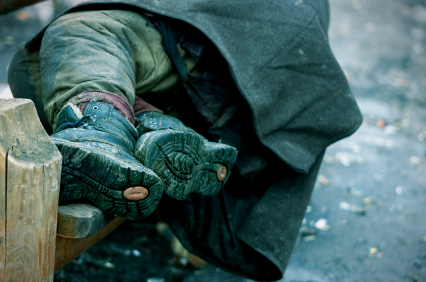Rent a few flats, then let them free to those sleeping rough. It works in America, so why not here?
Every Christmas we see two warring camps loosing a volley of accusations at each other. The cause: what to do about rough sleepers. Make no mistake, this debate is a matter of life and death. Life expectancy on the street is as low as 42.
On one side stand some London boroughs and homeless charities who feel that the plentiful volunteer soup runs in the capital serve only to keep people on the streets. Opposing them are Ken Livingstone, the Mayor of London, and other charities, who argue that trying to make such soup runs illegal is cold-hearted and will lead to starvation. But both sides have missed the potential of one novel — some might say outrageous — solution tested in America.
Ten years ago the rough sleeping population in England was more than 2,000 a night. Since then a combination of government focus, lots of money and greater co-operation between boroughs and charities has caused these numbers to fall by two thirds. Most new arrivals today will spend fewer than four nights on the street, and it’s vital to keep that number low. After living rough for more than a couple of weeks, habits are formed, addictions are acquired or exacerbated and rescue becomes even more difficult.
In London we are now down to the familiar hardcore cases who have refused so far to be helped. But these chronic rough sleepers are a tough group to help. The likes of Ed Mitchell, the former ITN presenter, driven on to the streets by huge debts is a rarity. Most are casualties of encounters with the State (60 per cent have either been in care, the Army, prison or all three), 70 per cent have mental health problems, 80 per cent have a drink or a drugs problem. Suspicious, paranoid and often irrational, they live a chaotic and brutal life, one 35 times more likely to end in suicide.
Getting them inside is a drawn-out process of contact, familiarisation, flattery and persuasion, the assumption being that the system that has worked well thus far should work for these remaining hard cases; we just need to work harder on them. This logic is flawed. Instead, we need a radical new approach.
In the New Yorker last year, Malcolm Gladwell maintained that chronic homelessness is a problem that can be abolished, not merely managed, because in the end it can be reduced to solving a few hard cases. When you do the maths, he says, the answer becomes clear: just give them a house.
In a number of cities across the United States, they are doing the maths. They discovered to their astonishment that leaving rough sleepers on the street costs a fortune. In Boston a study found that a group of 119 rough sleepers had been admitted to hospital 18,834 times in five years at the cost of $32,000 each a year. In San Diego a similar exercise with 15 of their homeless revealed a bill of $3 million over an 18-month period. In Reno, Nevada, one ten-year veteran rough sleeper had cost the city a cool $1 million with absolutely no improvement to his way of life.
In St Louis, Missouri, they went one step farther. Abandoning the usual approach to rough sleepers, where permanent housing is seen as the goal of rehabilitation, the city authorities decided to make housing the first step on the journey back to normality, not the last. They simply rented some apartments, approached their hardest cases, gave them the keys to their own free homes, and showed them how to get there. No strings, no process, no hassle. It worked. The toughest of vagrants started coming inside.
Of course it isn’t quite that simple. With the litany of problems, physical and mental, that assail the majority of rough sleepers, huge amounts of support are needed to maintain a life inside. But how much better and cheaper to support and manage their needs indoors than out. And boy, do we have the skills to do that.
Over the past ten years, local authorities, charities and church groups have become masters at keeping people indoors once they get there, but it’s getting the last few through the door that is the problem.
The logjam could be broken and the warring factions reunited by doing exactly what the Americans are doing: giving away homes free to chronic rough sleepers, and then working to keep them indoors.
Are you spluttering “Just give them a flat?! The same flat I have to work all week to pay for? Are you mad?!”?
If the moral argument that we have a duty to the unfortunate doesn’t sway you, then the economics might. In Britain, though, the maths is hard to do. Government direct spending on rough sleepers is hidden within general housing grants and we have absolutely no idea what burden this small, troubled group places upon the NHS. Throw in local authority spending, and the budgets of the many homeless charities, and my rough estimate puts the number at anything up to £30,000 a year for each rough sleeper: enough to rent a one-bed flat in Chelsea and pay the minimum full-time wage, and have change left over.
Whatever the exact number, it should be big enough to shock you. Perhaps big enough that we might cut our losses and give rough sleepers the homes that save us money, and that might just save their lives.

